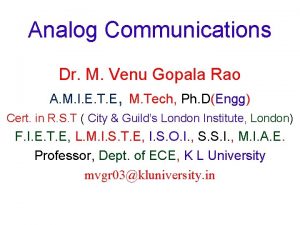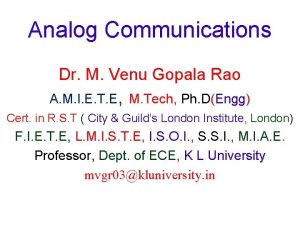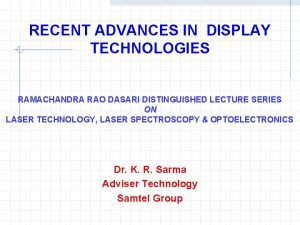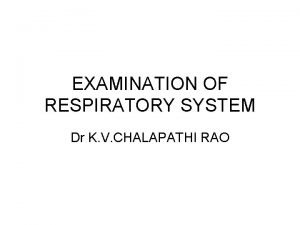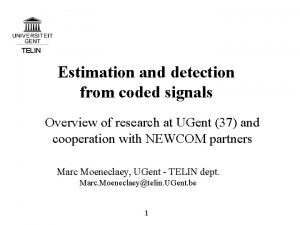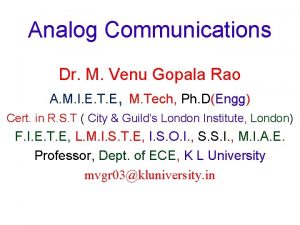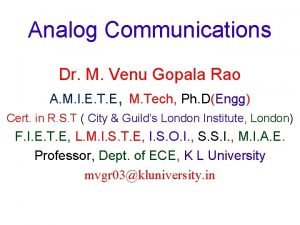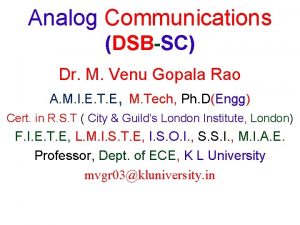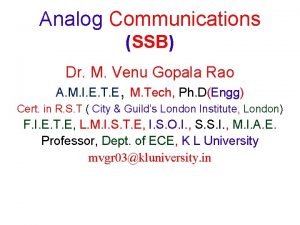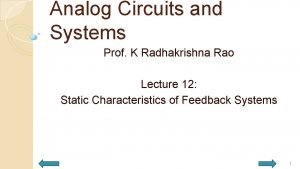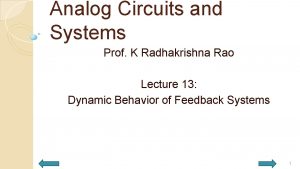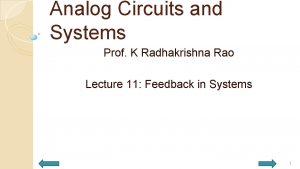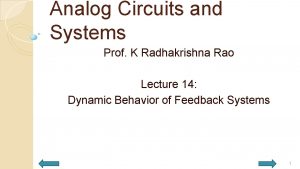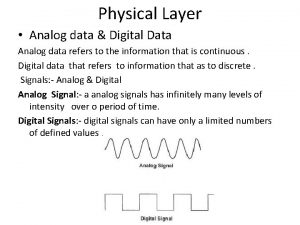Analog Communications Dr M Venu Gopala Rao A




















- Slides: 20

Analog Communications Dr. M. Venu Gopala Rao A. M. I. E. T. E, M. Tech, Ph. D(Engg) Cert. in R. S. T ( City & Guild’s London Institute, London) F. I. E. T. E, L. M. I. S. T. E, I. S. O. I. , S. S. I. , M. I. A. E. Professor, Dept. of ECE, K L University mvgr 03@kluniversity. in

Lectrure - 2 AMPLITUDE MODULATION

1. Amplitude Modulation (or simply AM) Introduction Single Tone, Multi tone and Baseband signals v Time domain description v Frequency domain description v Power and Current Relations 2. Modulators v. Switching Modulator v. Square Law Modulator 3. Demodulators v. Square Law Demodulator v. Detector Demodulator v. Envelope Detector 4. Virtues and Limitations of AM

2. AM Generation (AM Modulators)

1. Square-Law Modulator The diode-resistor equation is given by Where and are constants.

. Square-Law Modulator … The output of the non-linear device (diode) where The first term is the desired AM wave with amplitude sensitivity Remaining unwanted three terms are removed by appropriate filtering.

2. Switching Modulator The input voltage to the diode , where Then .

The desired components

3. AM Detectors / Demodulators

1. Square-Law Detector


2. Envelope detector


Diode detector advantages 1. Simplicity: (a) The diode detector is very simple and is easy to construct. (b) The circuit is very straight forward, consisting of a very few components. 2. Low cost: Requiring few components, and the fact that the components are not specialized, this form of detector is very cheap. Accordingly it is widely used in AM domestic radios. 3. Asynchronous detector: This detector does not depends on the frequency and the phase of the carrier at the receiver.

Limitations a) The input to the detector must be band-pass filtered around the desired signal, or else the detector will simultaneously demodulate several signals. b) filtering can be done with a tunable filter or, more practically, a superheterodyne receiver c) If the signal is overmodulated, distortion will occur d) Most of these drawbacks are relatively minor and are usually acceptable tradeoffs for the simplicity and low cost of using an envelope detector.

4. Virtues and Limitations of AM 1. Amplitude modulation is wasteful of transmitted power. The transmission of the carrier wave represents a waste of power. 2. Amplitude modulation is wasteful of channel bandwidth • As far as the transmission of information is concerned, only one sideband is necessary, and the communication channel therefore needs to provide only the same bandwidth as the message signal. • But AM requires a transmission bandwidth equal to twice the message signal bandwidth.

Modifications of AM 1. Double sideband-suppressed carrier (DSB-SC) modulation v The transmitted wave consists of only the upper and lower sidebands. v But the channel bandwidth requirement is the same as before. 2. Single sideband (SSB) modulation. v The modulation wave consists only of the upper sideband or the lower sideband. v To translate the spectrum of the modulating signal to a new location in the frequency domain. 3. Vestigial sideband (VSB) modulation v One sideband is passed almost completely and just a trace of the other sideband is retained. v The required channel bandwidth is slightly in excess of the message bandwidth by an amount equal to the width of the vestigial sideband.

Main Points of AM

Main Points of AM 6. The efficiency of AM wave depends on modulation index only and does not depend on either frequencies of modulating signal or carrier. 7. The maximum efficiency of AM occurs when and Maximum efficiency is 33. 33%. 8. The main disadvantage of AM is wastage of carrier power. 9. Another major disadvantage of AM is wastage of bandwidth which is twice of message signal bandwidth. 10. The main advantage of AM is that, since a coherent reference is not needed for demodulation as long as , the demodulator becomes simple and inexpensive. 11. In many applications, such as commercial broadcast, AM is sufficient to justify its use.

End
